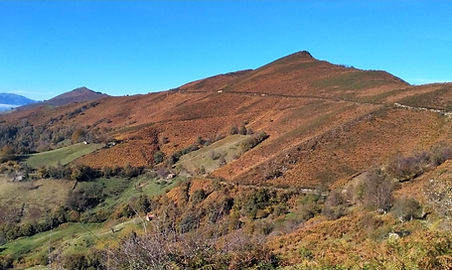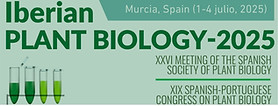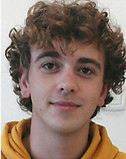
The fern Pteridium aquilinum or common fern, is present almost everywhere in the world, and is considered a problematic pest in forests and plantations, causing substantial financial and biodiversity losses. In areas where it coexists with an abundant livestock farm, there is a worrying incidence of well-defined pathologies or syndromes, almost all of which lead to a considerable loss in animal performance and, consequently, to the financial fragility of the farm. Continued ingestion of sublethal amounts of fern, i.e. small amounts that appear to have no effect, can lead to a variety of ailments, including bone marrow hypoplasia, thrombocytopenia, leukopenia, immunosuppression, reduced intestinal absorption of iron, thiamine (vitamin B1) deficiency, and severe internal bleeding. The most visible symptoms in farm animals, related to fern consumption, are weakness, lack of motor coordination of the hind legs and neck, propensity to acquire infectious diseases, breathing difficulties and nose, rectal and urinary bleeding. In cattle, the hemorrhagic syndrome is enzootic bovine hematuria (HEB), a chronic process characterized by bleeding in the urinary bladder and, in some cases, tumors in the bladder wall, identified in different parts of the world. Sheep are less prone than cattle to acute hemorrhagic effects, experiencing mainly brilliant blindness (retinal atrophy), while thiamine deficiency is mainly seen in horses. Among all these pathologies, HEB is the most important problem in livestock farms in many countries. In addition to animals, some human populations in Japan, New Zealand, Brazil, Canada, China, Korea, etc. consume young fronds and/or staffs, as they are considered a good source of protein, carbohydrates, fats, vitamins, carotenoids, and minerals. Potentially harmful substances identified include iludan glycosides, such as ptochyloside (PTA), caudataside (CAU), and ptesculentoside (PTE), indanones (various pterosines and pterosides), and thiaminases, among other compounds. The levels of these compounds can vary both between plants, according to the phenological stage, and also between the different parts of the plant (frond, rhizome, spore); and different levels of toxins have also been detected in plants in different areas. Therefore, in each region where the impact of the fern on the rest of the biota is important, it would be necessary to determine this variability, and also to quantify the most relevant toxins. Many scientific articles refer to Pteridium as the only plant known to cause cancer naturally in animals. Their carcinogenicity is primarily based on iludan glycosides, as demonstrated decades ago in several independent experiments conducted in Japan and the Netherlands. It has been estimated that PTA accounts for more than 50% of the fern's carcinogenic potency.
The aim of the project was to study whether plants in fact from different locations in Asturias (different altitudes and soils) present differences in the content of iludan glycosides and their metabolites, and to check whether the different content would be related to differences in genotoxic activity. Despite research conducted in other countries on the risk of exposure to fern, there is no information on these possible relationships.

Although only some of the researchers involved in this project have been starting to study the threat that Pteridium represents for aspects as important as biodiversity, and health of livestock and people living around these plants and, therefore, exposed to their toxicity, we have put together a team, with experts on different fields, capable to cope with each of the goals proposed, as indicated by the following research information: Dra. Elena Mª Fernández González is Associate Professor in the Area of Plant Physiology, at the University of Oviedo. She has focussed all her career to different topics on ferns, by using biotechnological tools, such as in vitro culture techniques, which provides an important background on the vegetative and reproductive biology of the gametophyte generation. Moreover, she has been trained in chromatography coupled to mass spectrometry (HPLC & GC), phytohormonal analyses, and lastly in proteomic studies. In the last years, proteomic data from gametophytes of the apogamous fern Dryopteris affinis ssp. affins have been reported for the first time, which has contributed to get acquaintance with probable biological functions for more than one thousand proteins, with important repercussion in evolution and developmental studies, reproduction, phytohormone signalling and biosynthesis, and biotic and abiotic stress, among others metabolic processes. Dra. Luisa María Sierra Zapico is Associate Professor in the Area of Genetics, at the University of Oviedo. She has expended all her academic career studying the effects of exposure to chemicals that induced DNA damage, in terms of DNA damage detection, its repair and its consequences (gene and chromosomal mutations), that is DNA damage response, using the model organism Drosophila melanogaster to carry out in vivo analyses, and human cell lines to carry out in vitro ones. Dr. Juan Pedro Majada Guijo, PhD in Biological Sciences from the University of Oviedo. Stays at INRA and CNRS in Bordeaux. He worked for several years as a consultant in Portugal for the multinational Stora-Enso, developing breeding programmes and industrial production systems. He joined in 2002, with a Ramón y Cajal contract of the INIA system, the Agri-Food Research and Development Service of Asturias and, in 2008, he was hired under the state programme I3, by the Principality of Asturias, for the creation and development of the Forestry and Wood Technology Centre, of which he has been the director since 2009. He is author of more than seventy SCI publications and has participated in numerous funded projects, several of them as PI of the national R&D plan. Dr. Elena Canga Líbano PhD. Researcher at CETEMAS (Forest and Wood Technology Research Centre Foundation). Research areas: forest growth, forest planning, fire risk, pest and diseases & geomatics. Her research focuses on the following aims: 1) forest growth modelling, 2) forest management, 3) forest planning, 4) LiDAR and multispectral analysis with different objectives (forest growth, health, fire risk, etc.). Part-time instructor in Degree in Forestry and Natural Resources at the University of Oviedo, in the following courses: Reforestation and Restoration of degraded land, Management of Protected Areas, and Management of Threatened Species. Dr. José Manuel Alvarez Díaz is Assistant Professor (Profesor Contratado Doctor) at the University of Oviedo. He has skills in Plant Physiology and Biotechnology. He has extensive research experience in plant development, functional characterization of candidate genes in homologous and heterologous systems, and bioinformatics analyses. He is an expert in forestry. Dr. Isabel Díaz Feito PhD in Biology, currently researcher at SERIDA, integrates the necessary knowledge in the processes of plant development combined with an applied view, result of more than 20 years of experience in the field of Horticulture, Floriculture and Forests, with topics such as nutrition, pests and other aspects of interest in an Integrated Management and Sustainable Agriculture. Her research in the field of Plant Physiology, focusing on the study of Hormonal Metabolism and the participation of Plant Growth Regulators as inducers of the signal cascade that regulates the interaction of plants with their environment allowed to getting acquaintance in several analytical techniques, like mass spectrometry LC/MS. Recent relevant publications: Dr. Elena María Fernández 2022. Jonhson M, Fernández H, Kumar A, Shibila T (eds.). Ferns: Biotecnology. Micropropagation, Medicinal uses and Environmental regulation. Springer-Singapore. https://link.springer.com/book/9789811661693 2022. Fernández H and Sierra L. María. Pteridium aquilinum: a threat for biodiversity and human and animal health. In: Jonhson M, Fernández H, Kumar A, Shibila T (eds.). Ferns: Biotecnology. Micropropagation, Medicinal uses and Environmental regulation. Springer-Singapore. https://link.springer.com/book/9789811661693 2021. Fernández H, Grossmann J, Gagliardini V, Feito I, et al. Sexual and apogamous species of woodferns show different protein and phytohormonal profiles. Frontiers in Plant Science. 12 November. 2020. Wyder S, Rivera A, Valdés AE, et al. Differential gene expression profiling of one- and two-dimensional apogamous gametophytes of the fern Dryopteris affinis ssp . affinis. Plant Physiol Biochem 148:302–311. doi: 10.1016/j.plaphy.2020.01.021 2021. Barredo B. Analysis of the possible genotoxicity of water from troughs surrounded by Pteridium aquilinum, in Drosophila melanogaster in vivo. Project End of Degree. Dpts. BOS and Functional Biology. University of Oviedo. 2021. San Juan J. Genotoxicity of plant extracts from Pteridium aquilinum in Drosophila melanogaster in vivo. Project End of Degree. Dpts. BOS and Functional Biology. University of Oviedo. 2018. Fernández H. Current Advances in Fern Research. Ed. Springer. NY ISBN 978-14-4197-161-6 2017. Grossmann J, Fernández H, Pururawa M Chauvey et al. Proteogenomic analyses greatly expands the identification of proteins *Fernández H has collaborated in the publication of Skarbic et al. 2021, doing the sampling work in the spots included from Spain. See Acknowlegments in the paper. Dr. Luisa María Sierra 2022.Fernández H and Sierra L. María. Pteridium aquilinum: a threat for biodiversity and human and animal health. In: Jonhson M, Fernández H, Kumar A, Shibila T (eds.). Ferns: Biotecnology. Micropropagation, Medicinal uses and Environmental regulation. Springer-Singapore. https://link.springer.com/book/9789811661693. 2021. Fernández Asensio, A., E. Álvarez-González, A. Rodríguez, L.M. Sierra, E. Blanco-González. Chromatographic methods coupled to mass spectrometry for the determination of oncometabolites in biological samples- A Review. Analytica Chimica Acta 1177: 338646. Doi: 10.1016/j.aca.2021.338646. 2021. Fernández-Villabrille, S., E. Álvarez-González, F. Barros, P. De La Peña, L.M. Sierra. Influence of Kv11.1 (hERG1) K+ channel expression on DNA damage induced by the genotoxic agent methyl methanesulfonate. Pflügers Archiv - Eur J Physiol 473:197–217. Doi: 10.1007/s00424-021-02517-2. 2019. Fernández Asensio, A., L.M. Sierra, M. Montes-Bayón, E. Blanco-González. Sensitive determination of the human epidermal growth factor receptor 2 (HER2) by immuno-polymerase chain reaction with inductively coupled plasma-mass spectrometry detection. Analytica Chimica Acta 1090: 39-46. Doi: 10.1016/j.aca.2019.09.047. 2018. Fernández Asensio, A., T. Iglesias, A. Cotarelo, M. Espina, E. Blanco-González, L.M. Sierra, M. Montes-Bayón. Multiplex polymerase chain reaction in combination with gel electrophoresis-inductively coupled plasma mass spectrometry: A powerful tool for the determination of gene copy number variations and gene expression changes. Analytica Chimica Acta 1023: 64-73. Doi: 10.1016/j.aca.2018.03.047. 2017. Espina, M., Corte-Rodríguez, M., Aguado, L., Montes-Bayón, M., Sierra, M.I., Martínez-Camblor, P., Blanco-González, E., Sierra, L.M. Cisplatin resistance in cell models: evaluation of metallomic and biological predictive biomarkers to address early therapy failure. Metallomics 9:564-574. Doi: 10.1039/c7mt00014f. 2014. Gaivão, I., L.M. Sierra. Drosophila Comet Assay: insights, uses and future perspectives. Frontiers in Genetics- Genomic Assay Technology. Vol. 5: 304. Doi: 10.3389/fgene.2014.00304. 2013. Uriol, E., M. Sierra, M.A. Comendador, J. Fra, P. Martínez-Camplor, A.J. Lacave, L.M. Sierra. Long-term biomonitoring of breast cancer patients under adjuvant chemotherapy: the Comet assay as a possible predictive factor. Mutagenesis 28(1): 39-48. Doi: 10.1093/mutage/ges050. Dr. Isabel Feito Díaz 2021. Navazas A, Thijsb S, Feito I, Vangronsveld J, Peláez AI, Cuypers A, González A. Arsenate-Reducing Bacteria Affect As Accumulation and Tolerance in Salix atrocinerea. Science of the Total Environment 0048-9697. DOI: 10.1016/j.scitotenv.2020.144648 2020. Fuente-Maqueda F, Rodriguez A, Majada J, Fernandez B, Feito I. Methodology optimization for the analysis of phenolic compounds in chestnut (Castanea sativa Mill.) Food Science and Technology International 26(6) 520-534. DOI: 10.1177/1082013220911782 2020. Alvarez JM, Bueno N, Cuesta C, Feito I, Ordas, RJ. Hormonal and gene dynamics in de novo shoot meristem formation during adventitious caulogenesis in cotyledons of Pinus pinea. Plant Cell Reports 39: 527-541. DOI: 10.1007/s00299-020-02508-0. 2018. Trapiello E, Feito I, Gonzalez AJ. First Report of Gnomoniopsis castaneae Causing Canker on Hybrid Plants of Castanea sativa x C. crenata in Spain. Plant Disease 102(5): 1040. DOI: 10.1094/PDIS-12-17-1874-PDN. 2017. Delatorre C, Rodriguez A, Rodriguez L, Majada JP, Ordas RJ, Feito I. Hormonal profiling: Development of a simple method to extract and quantify phytohormones in complex matrices by UHPLC-MS/MS. Journal of Chromatography B-Analytical Technologies in the Biomedical and Life Sciences 1040: 239-249. DOI: 10.1016/j.jchromb.2016.11.007 Dr. Juan Majada 2021. Sierra-de-Grado R, Pando V, Voltas J, Zas R, Majada J, Climent J. Straightening the crooked: 2 intraspecific divergence of stem posture control and associated trade-offs in a model conifer. J. Exp. Bot. (In press). 2020. Prada M, Cabo C, Hernández-Clemente R, Hornero A, Majada J, Martínez-Alonso C. Assessing Canopy Responses to thinnings for Sweet Chestnut Coppice with time-Series Vegetation Indices Derived From Landsat-8 And Sentinel-2 Imagery. Remote Sensing 12 (18), 30684. 2019. Prada M, González-García M, Majada J, Martínez-Alonso C. Development of a dynamic growth model for sweet chestnut coppice: a case study in Northwest Spain. Ecological Modelling 409.5. 2017. Fernández, E., Majada, J., Casares, A. Efficacy of Propidium Iodide and FUN-1 stains for assessing viability in basidiospores of Rhizopogon roseolus. May 2017. Mycologia 109(2):1-9. DOI. 10.1080/00275514.2017.13234652. 2016. Hevia, A., Álvarez-González, J.G., Ruiz-Fernández, E., Prendes, C., Ruiz-González, A. D., Majada, J., González-Ferreiro, E. Modelling canopy fuel and forest stand variables and characterizing the influence of thinning in the stand structure using airborne LiDAR. Active Remote Sensing in Forest Applications 45:41-55.3. Dra. Elena Canga 2022. Prada M, Canga E, Majada J, Martínez-Alonso C. Canopy characterization of sweet chestnut coppice in the North of Spain.European Journal of Forest research (aceptado). 2021. Prendes C, Cabo C, Ordóñez C, Majada J, Canga E,.An algorithm for the automatic parametrization of wood volume equations from Terrestrial Laser Scanning point clouds, application in Pinus pinaster. GIScience & Remote Sensing, 58:7, 1130-1150 2019. Prendes C, Buján S, Ordóñez C, Canga E. Large scale semi-automatic detection forest roads from low density LiDAR data on steep terrain in Spain. iForest-Biogeosciences and Forestry. Vol 12, 366-374. Dr. José Manuel Alvarez Díaz 2021. Bueno N, Cuesta C, Centeno ML, Ordás RJ, Alvarez JM. In vitro plant regeneration in conifers: The role of WOX and KNOX gene families. Genes 12(3): 438. doi: 10.3390/genes12030438 2020.Bueno N, Alvarez JM, Ordás RJ. Characterization of the KNOTTED1-LIKE HOMEOBOX (KNOX) gene family in Pinus pinaster Ait. Plant Science 301: 110691. doi: 10.1016/j.plantsci.2020.110691 2020. Alvarez JM, Bueno N, Cuesta C, Feito I, Ordás RJ. Hormonal and gene dynamics in de novo shoot meristem formation during adventitious caulogenesis in cotyledons of Pinus pinea. Plant Cell Reports 39(4): 527-541. doi: 10.1007/s00299-020-02508-0. 2015. Alvarez JM, Sohlberg J, Engström P, Zhu T, Englund M, Moschou PN, von Arnold S. The WUSCHEL-RELATED HOMEOBOX 3 gene PaWOX3 regulates lateral organ formation in Norway spruce. New Phytologist 208(4): 1078-1088. doi: 10.1111/nph.13536. 2014.Zhu T, Moschou PN, Alvarez JM, Sohlberg JJ, von Arnold S. 2014. WUSCHEL-RELATED HOMEOBOX 8/9 is important for proper embryo patterning in the gymnosperm Norway spruce. Journal of Experimental Botany 65(22): 6543-6552. doi: 10.1093/jxb/eru371.



Helena Fernández

Isabel Feito

Jose Manuel Alvarez

María Sierra

Juan Majada

Elena Canga

Alexis Eduardo Peña
Meetings



Los trabajos realizados en esta parte del proyecto constituyeron los Trabajos Fin de Grado de 5 estudiantes del Grado en Biotecnología y el Trabajo Fin de Máster de un estudiante del Máster Universitario en Biotecnología Aplicada a la Conservación y Gestión Sostenible de Recursos Vegetales, todos de la Universidad de Oviedo. TFG. 2021. Jaime San Juan. Genotoxicidad de extractos de Pteridium aquilinum en Drosophila melanogaster in vivo. TFG. 2021. Bernardo Barredo García. Análisis de la posible genotoxicidad de aguas de abrevaderos rodeados Pteridium aquilinum, en Drosophila melanogaster in vivo. TFG. 2022. Ivan Iglesias Antunez. Efecto del tiempo de extracción en la genotoxicidad de extractos de Pteridium aquilinum en Drosophila melanogaster in vivo TFG. 2023. Marta Martín Jiménez. Determinación de actividad genotóxica en extractos acuosos de plantas de Pteridium aquilinum recogidas en Parques Naturales de Asturias TFG. 2024. Alejandra Cué Avello. El ensayo SMART de Drosophila en el análisis in vivo de la actividad genotóxica de extractos acuosos de plantas de Pteridium aquilinum, recogidas en distintos lugares de los Picos de Europa, y su posible relación con los niveles de glicósidos iludanos TFM. 2024. Darío López López. Determinación de la actividad genotóxica de extractos acuosos de plantas de Pteridium aquilinum (L.) Kuhn recogidas en distintas localizaciones, y a diferentes altitudes, en el Principado de Asturias.

Jaime San Juan

Bernardo Barredo

Ivan Iglesias

Marta Martín

Darío López





















